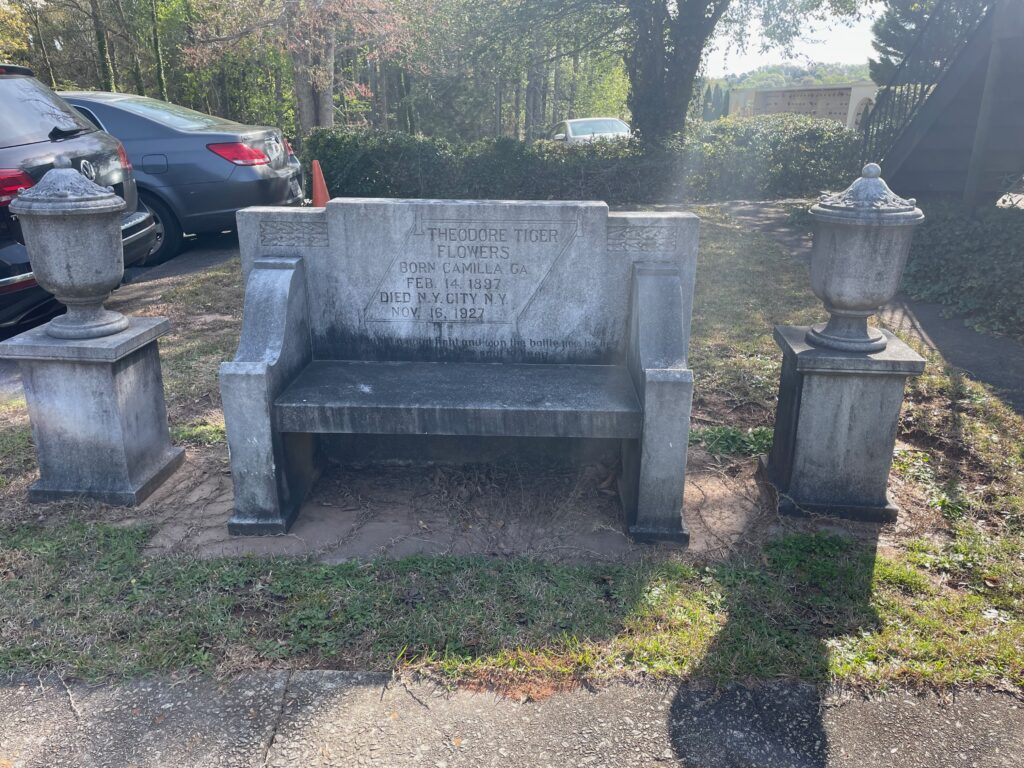Erik Visits an American Grave, Part 1,408
This is the grave of Tiger Flowers.

Born in 1895 in Camilla, Georgia, Theodore Flowers grew up in the horrible conditions of Jim Crow. He got a job as a stevedore, which was one of those hard labor jobs where Black Americans could get work. He was working in Savannah but then moved to Philadelphia in 1918. This was the period when the Great Migration started and so he followed a lot of other people north.
Flowers started boxing in Philadelphia. He probably boxed some in Georgia too, but he became a professional in Philadelphia and he was very good. He become one of the top middleweights of the early 20th century. But for as brutal as boxing (or MMA) is today, it was far more so back then simply because fighters were in the ring all the time. They fought constantly and of course the impact on their bodies was overwhelming. Such would be the case with Flowers, eventually. 160 fights will do that to a man, not even counting amateur bouts, exhibitions, and the like. But let’s hold off on that for a bit here.
Flowers was a good boxer and he rose rapidly. He also brought first rate showmanship into the ring. See, he was a good Christian man, which let’s face it, is not the usual persona of the prizefighter. He didn’t drink and I don’t think he gambled. He read his Bible. In fact, he brought his Bible into the ring and would read it aloud before his fights. His ultimate nickname would be “Tiger” but for awhile, he was known as “The Deacon.” Good stuff from an entertainment perspective.
Flowers was, again, very good, but he faced the big problem that all Black boxers faced. Whites really didn’t really want to fight them. That’s because the whites were scared of losing and making themselves look bad. In sports, the point of the color line was to protect cowardly whites from competition. That was very true in boxing, especially after Jack Johnson showed that a Black man could win the heavyweight title, which at that time was the pinnacle of American sports. It would be decades before a white boxer would fight a Black boxer for the title again. But as Flowers rose, it became harder for these white boxers to avoid him. Moreover, the middleweights had less public pressure to remain strictly segregated than the heavyweights. Earlier in his career, Flowers would just pummel the same Black boxers over and over again because those are the bouts he could get. But later, leading white fighters including Maxie Rosenbloom, Sam Langford, and Mickey Walker did fight him and quite often, Flowers won those bouts.
By 1924, the middleweight title was held by The Pittsburgh Windmill himself, Harry Gelb. The Ring named Flowers the top contender and it was going to be hard for Gelb to avoid Flowers now. It finally happened in 1926. By this time, Greb was not at the top of his game. In a brutal bout with a questionable decision by the judges, Flowers beat him and then Flowers defended the title in another controversial decision later that year. He was the champ.
But Flowers didn’t hold the title long. He lost yet another controversial decision to Mickey Walker in December 1926. The match was so sketchy that it was investigated for corruption, but allowed to stand. Flowers wanted that title back. He put himself back in the ring almost immediately to prepare and fought like 15 fights over the next several months.
However, Flowers just had fought too much. He had big time scar tissue on his face and around his eyes and brain. He had surgery to remove some of it in 1927. He did not survive that surgery. In fact, just before he died of it, Harry Gelb died trying the same surgery. Basically, both Flowers and Gelb weren’t just punch drunk. They were punch dead. Flowers was 32 years old. In his career, Flowers was 135-17-8. That’s….a lot of fights.
Flowers was such a big deal in the Black community in Atlanta (he remained involved in religious matters until his death and was a member of leading fraternal organizations) that 75,000 people came to pay their respects. He actually has a cemetery named for him in Lakeland, Florida. But that is not where is buried. Oh also, he is referenced in a Run the Jewels song, which is not something many early 20th century boxers can say!
Tiger Flowers is buried in Lincoln Cemetery, Atlanta, Georgia.
If you would like this series to visit other pugilists, you can donate to cover the required expenses here. Flowers was inducted in 1993 in the Old Timers category. Maxie Rosenbloom, also inducted that year and one of Flowers’ opponents, is in North Hollywood, California. Tommy Gibbons, the heavyweight also inducted in 1993, is in Saint Paul, Minnesota. Previous posts in this series are archived here and here.


